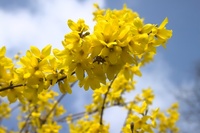
A houseplant that looks striking all year round thrives on neglect and is easy to grow: Yucca. What more could you ask? Yuccas make great houseplants, looking rather like indoor palm trees with their bare stems and rosettes of long leaves. Although mature Yuccas can eventually reach a height of several metres, they are very slow-growing and will live happily in pots for a long time.
Types of Yucca
There are more than twenty different species of Yucca, but the two most commonly grown indoors are Yucca guatamalensis (previously called Yucca elephantipes), and Yucca alifolia. Both have long, sword-shaped leaves, but the leaves of Yucca alifolia are stiff and tipped with very sharp spines. Yucca guatamalensis leaves are softer and arching, with no spines.
NB: Yucca leaves contain saponins, which are toxic to cats and dogs if eaten.
How to grow Yucca plants
Yuccas do best in bright but indirect light. In winter, a sunny, south-facing window is ideal. In summer, provide some light shading to protect the leaves from the hot midday sun, or move the plant to the west- or east-facing window.
Yuccas don’t need a particularly fertile growing medium, but it must be free-draining, while still being heavy enough to hold the plant securely. A mixture of 1 part sand to 3 parts multipurpose compost is ideal.
How to care for a Yucca plant
Yuccas are very easy to care for – simply follow these tips:
- Don’t overwater. Yuccas are desert plants, so are very drought tolerant, and overwatering may kill them. In summer, wait until the top half of the compost in your container is dry before watering. Water very sparingly in winter. Never leave the plant sitting in water.
- In spring and summer, feed monthly with a general houseplant food diluted to half-strength.
- Yuccas will naturally grow towards the light, so turn indoor plants regularly to keep them from getting lopsided.
- Yuccas do not need regular pruning, but if a plant is getting too tall, cut it back in spring, reducing the height by half.
How to propagate Yucca plants
Yuccas can be propagated easily from offsets. These are shoots that appear at the base of the plant. Remove them in spring when the plant is starting to grow, cutting each offset off at the point where it joins the main plant. Leave the offsets out to dry for a few days, then push the bases into a mix of compost and coarse horticultural sand. Please place them in a propagator with a bottom heat of 18ºC (65ºF), or cover them with a clear plastic bag and put them somewhere bright and warm, out of direct sunlight. Don’t water for the first couple of weeks, until the shoots have developed roots.




